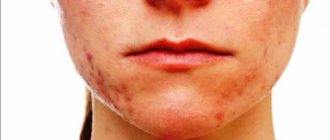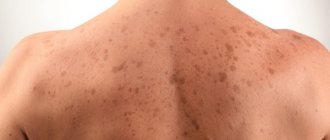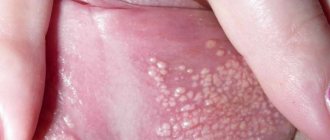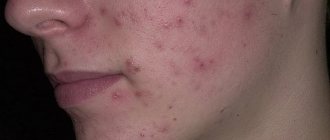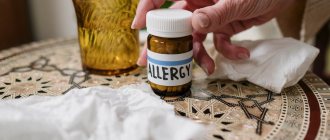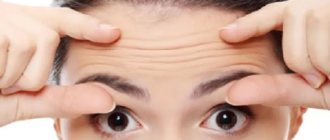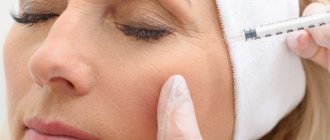| Appointment with a dermatologist at the clinic. Call a dermatologist at home. | Reception is strictly by appointment, make an appointment by phone: +7 | Prices for services | Reviews about the clinic |
The skin is the largest human organ and the most sensitive to changes in the body. If there are malfunctions in the functioning of internal organs or if there is an adverse effect on the body, the skin reacts with rashes. This symptom must be taken seriously. You should visit your doctor without delay.
It is important to find out whether the rash is infectious or allergic in nature. Both require timely treatment, and sometimes isolation of the patient if the disease is contagious. Our clinic offers the services of experienced specialists, as well as sufficient facilities for modern, accurate laboratory and diagnostic tests.
Make an appointment with a dermatologist by phone or by filling out the online form
| Select a clinic | Demodicosis | Rash on shoulders | Calling a dermatologist to your home |
Answers to frequently asked questions about skin rashes:
- Which doctor should you contact for a skin rash?
- Is the skin rash contagious?
- What diet is necessary for skin rashes?
- What diagnosis is needed for a skin rash?
- Why is a skin rash dangerous?
- Why is it necessary to get tested for a skin rash?
- What diseases does a skin rash indicate?
- What examination is necessary for a skin rash?
- Which skin rash is dangerous?
- How to distinguish an allergic rash from an infectious one
- How to get rid of skin rashes?
- How to get rid of itching skin rash?
- What organs are affected by a skin rash?
- How to prepare for an appointment with a dermatologist?
- How to get checked for skin diseases?
- What diseases does a dermatologist treat?
- What tests should be taken by a dermatologist?
- What diagnostics can a dermatologist perform in the clinic?
- Where to go with a skin disease?
Symptoms of acne in papulopustular form
Acne vulgaris in the papulopustular form manifests itself in the form of papules and pustules. These acne elements have their own differences18,97:
- Papules. Small inflammatory nodules of a conical or hemispherical shape. Their diameter is 2-4 mm. They have a bluish-red color and elastic consistency. Their full development cycle is about 10-12 days. After their resolution, post-inflammatory spots may remain.
- Pustules. Inflammatory nodules, inside of which a cavity is formed filled with pus. They, like papules, have a red-blue color. Over time, the purulent contents dry out and a crust forms on the surface. After its removal (intentional or spontaneous), a trace remains on the skin - post-inflammatory hyperpigmentation.
Pustules can form on their own or transform from papules.
What is a pustule?
A pustule is the primary inflammatory element of a rash, which is a purulent process in the dermis or epidermis. Inside the pustule is pus, which may be gray or white. If the pus has a greenish or yellow tint, then the pustule is a consequence of infection. Sizes range from one to 10 millimeters. Typically, painful redness can be observed around the purulent head. By nature there are follicular and non-follicular. Follicular pustules form in the hair follicle, hence their name. Non-follicular - develops outside the hair follicle. Pustules also differ in shape: cone-shaped, flat, spherical. Sometimes when you press on a pustule, it may be accompanied by a painful reaction.
Why do papulopustular acne appear?
Heredity influences how acne develops and progresses. There is a genetic predisposition to hyperandrogenism, hypersensitivity of the sebaceous gland receptors to androgens, increased activity of 5-alpha reductase, which is involved in the conversion of testosterone to DHT. It is DHT that helps increase sebum production.29
Inflammation in acne can be either aseptic, developing in sterile conditions, or reactions to substances produced by propionibacteria. 29
Clindovit® gel is a topical antibiotic. Its main active ingredient is clindamycin phosphate. The drug exhibits antimicrobial activity against propionibacteria.6
The causes of acne can be associated with diseases of internal organs and systems, for example, the gastrointestinal tract; rashes can be a consequence of dysbacteriosis, hypovitaminosis, metabolic disorders, and decreased immunity. 29
The causes and treatment of acne are interrelated. So, if the rashes in women are of a hormonal nature, in addition to topical therapy, oral contraceptives may be prescribed. 29
Types of allergic rashes
An allergic reaction occurs when any external or internal allergen enters the body. Usually expressed as rashes and itching. The human body makes every effort to neutralize the allergen. The blood vessels dilate, the skin becomes red and inflamed, and swelling appears. You must call an ambulance immediately.
Sometimes allergies occur in a milder form. The main types of allergic rashes:
- Hives. It can appear in the form of medium to large blisters. They sometimes merge with each other. The blisters are matte in color and have a pink border around the edges.
- Atopic dermatitis. The skin is itchy, dry and irritated. This is a reaction to plants, animals, certain types of food, perfumes and deodorants, household chemicals, creams and dust, and medications.
- Contact dermatitis. Blisters appear on the body, the skin turns red and itches. Rashes are localized where the allergen has entered, as a reaction to cosmetics, synthetic clothing, and medications.
- Eczema. It is most often localized on the hands and face. These are numerous pinpoint rashes with serous fluid. Causes severe itching. This may be due to stress, disruption of the endocrine system, metabolism, reaction to food, cosmetics, household chemicals.
There is also toxicoderma, neurodermatitis, Leyell's syndrome and so on. An experienced dermatologist or allergist will help determine the diagnosis and prescribe appropriate treatment.
Common symptoms and manipulations in dermatology:
- Skin rashes
- Calling a dermatologist to your home
- Itching in the urethra
- Itchy skin
- Skin rash
- Prevention of casual sex
- Skin neoplasms
- Pyoderma
- Pityriasis rosea
- Streptoderma
- Scabies
- Peeling skin
- Fungal infections
- Skin infection
- Pus on the skin
- Blisters on the skin
- Papillomas on the foreskin
- Sexually transmitted diseases
- Skin structure
Treatment of papulopustular acne
Treatment of papulopustular acne depends on the severity of the disease. If there are many comedones and only a few papules on the skin, most likely the patient has mild acne, for which topical medications are prescribed. If there are more than 10 papules and pustules, this indicates an average severity, for which treatment should be combined, including systemic medications. 18
Clindovit® gel is intended for the treatment of mild to moderate acne. It should be applied to previously cleansed skin 2-3 times a day.6
In addition to medication, there are other methods of treating acne. Thus, the use of laser and phototherapy is considered effective. Ozone therapy is also used. But each of these methods has its own contraindications, which in most cases include the inflammatory process. With the help of drug treatment, it is possible to achieve remission, and hardware methods will help prolong it and improve the condition of the skin.
What are papule and pustule
Papule is an element of the rash, localized in the upper layers of the skin; the attributes do not have a cavity with pus or liquid. They have a mild course, may be accompanied by inflammation, and there is no discomfort when touching the affected area.
After the development of papules and pustules is completed, there are no traces or scars left on the skin. Formations can appear with syphilis, meningitis, an allergic reaction, or occur after a scabies mite bite.
A pustule is a formation with a head, a capsule filled with purulent masses that provoke inflammation, unlike papules. When an element ruptures, a substance leaks out and a dry crust appears on the skin. If the formations are isolated in nature and are not accompanied by pathological processes, they disappear without a trace.
In case of profuse rashes with pronounced discharge, an examination is carried out for the presence of pathologies.
Diagnostic methods
If papules, pustules, or vesicles appear, it is recommended to visit a dermatologist, consult with an infectious disease specialist, venereologist or allergist. At the appointment, the doctor interviews the patient, examines the skin using a dermatoscope, and prescribes a series of examinations.
The following diagnostic techniques are used:
- liver tests;
- stool analysis for worm eggs;
- skin allergy tests;
- bacterial sowing;
- biopsy;
- general and biochemical blood tests;
- chest x-ray;
- HIV test;
- plasma analysis for hormone levels;
- skin scraping microscopy;
- urine test.
How to get rid of spots on a child's skin?
It is prohibited to independently fight epidermal diseases in a child.
The problem should be solved by a specialist, based on the results of the examination. To treat spots on a baby’s skin, medications of different effects are used, depending on the cause of the development of the pathological process.
To relieve redness and itching, ointments and gels with anti-inflammatory, softening and drying properties are used.
Pustule with deep ulceration
According to localization, pustules are deep and superficial, non-follicular and follicular.
Superficial pustules are called impetigo. They usually occur as a result of exposure of the patient's skin to pathogenic microorganisms (most often streptococci and staphylococci).
Staphylococcal pustules are follicular, since the inflammatory process mainly involves the sebaceous glands and hair follicles. Streptococcal pustules resemble blisters in appearance and are nonfollicular.
Deep pustules are located in the subcutaneous fat or dermis. Staphylococcal follicular deep pustules include hidradenitis, carbuncle, and furuncle, which rise above the surface of the skin, have a conical shape and are extremely painful.
Streptococcal deep pustules are called ecthymas. They are not tense, practically painless and only slightly rise above the skin.
A deeply ulcerated pustule that is located in the dermis resolves by ulceration and leaves behind a scar.
Pustules on the hands
Almost every adult has experienced the appearance of purulent pimples on their hands. This phenomenon is especially common in women. The cause of rashes is most often unfavorable external factors (household chemicals, cold air, and so on).
The appearance of pustules on the hands also occurs due to too dry skin, as well as as a result of hormonal imbalance in the body. If pustules often appear on your hands, it is recommended to consult a specialist; perhaps we are talking about some more serious disease.
Pustules on the face
Pustules on the face, photos of which can be seen below, are most often a symptom of acne.
Next on the list of causes are diseases such as chickenpox, measles, smallpox and a number of others.
Most often, acne is localized on the cheeks, a little less often on the forehead and chin. In some patients, rashes occur on the scalp.
Rashes on the face usually appear unexpectedly. The mechanism of their appearance and maturation is not much different from the processes of formation of other skin defects. Externally, pustules look like small balls filled with purulent contents. The skin around the lesions is red and inflamed. Pustules can be either single or multiple.
The appearance of acne is promoted by:
- Use of contraceptives. The likelihood of acne appearing on the face is especially high if the drug contains pure progesterone.
- Abuse of fat-based cosmetics. The fats contained in such preparations can cause blockage of skin pores, which leads to the development of an inflammatory reaction and the formation of acne. Therefore, it is better to use water-based cosmetics.
- Hormonal changes in the body (for example, before menstruation).
- Frequent sweating. Some people sweat quite often. This may be due to their physiological characteristics, living conditions, regular exercise, and so on. Such people should pay special attention to the condition of their skin and carefully care for it.
- Some medicines. The appearance of rashes on the face can be caused by taking bromides, corticosteroids, iodides, drugs containing lithium, and so on.
Treatment of acne on the face should be comprehensive. It is necessary not only to get rid of pustules directly, but also to influence the cause of their appearance. Only in this case can a positive and sustainable result be achieved.
How to treat?
To treat papular and pustular rashes, different methods are used: medications, folk remedies, and herbal medicine.
The choice depends on the type of disease diagnosed. For greater effectiveness, complex treatment is indicated. After eliminating the acute condition of a skin disease, spots and scars may remain on the body. To remove them, biorevitalization, mesotherapy, laser therapy, and grinding are used.
Drug therapy
To treat dermatological diseases, medications of different effects and release forms are used. Bacterial, viral, and fungal skin lesions are treated with antimycotics, antibiotics, and antiviral agents.
To relieve swelling and redness, anti-inflammatory and healing gels and creams are prescribed. To increase the body's defenses, doctors prescribe vitamin complexes.
For liver, intestinal and gastric disorders, medications are used aimed at restoring the functioning of the organ (hepatoprotective drugs, probiotics).
Treatment of spotty skin rash with folk remedies
Alternative medicine also provides a good healing effect. Herbal medicine is carried out and the healing properties of various products are used. Traditional healers recommend many recipes to combat spotty rashes on the skin.
The most effective folk remedies:
- one nutmeg, a little galangal and ginger, pour alcohol. Place in a warm place for a couple of days. Wipe the affected areas of the body with the prepared tincture. Additionally, it is recommended to drink a decoction of elderberry and yarrow flowers, one cup per day;
- Pour a tablespoon of oak bark into a glass of boiling water and simmer for a quarter of an hour. After cooling, strain the liquid. Wipe damaged tissues three times a day;
- lubricate the spotty rash with viburnum juice. Additionally, you should take an infusion: grind the berries and pour boiling water over a tablespoon. Leave for five hours and strain. Drink 150 ml 4 times a day;
- mix 100 g of purified sulfur and 300 g of pork fat. Apply to the affected area of skin until the spotty rash disappears.
Treatment of pustular psoriasis
The pustular form of psoriasis is the basis for hospitalization of the patient. Treatment is carried out comprehensively, in a hospital or sanatorium.
Drugs for the treatment of pustular psoriasis
All drugs are used only under the supervision of a physician. escortnavi.com. For pustular psoriasis, the following is taken orally for treatment:
Methotrexate
- detoxification drugs (saline solution, reamberin)
- antipyretic drugs;
- corticosteroids (prednisolone, dirospan);
- antihistamines;
- synthetic analogues of vitamin A (tigazon is the most effective);
- antimetabolites (metatrexate, mercatopurine);
To further treat the pustule, the doctor pricks it with a sterile needle. Then external preparations are used:
- aniline dyes;
- Polcortolon TS;
- potent corticosteroid creams (Dermovate);
- zinc ointment with hydrocortisone;
- synthetic analogues of vitamins A and D3.
Phototherapy for pustular psoriasis
Phototherapy is indicated only for stable disease and cannot be used during exacerbation. For pustular psoriasis, PUVA therapy and sometimes ultraviolet 311 nm are used.
PUVA therapy cabin
PUVA therapy is a method that combines medications and long-wave ultraviolet rays. First, the patient is given medicine, then irradiated in a special cabin. When treated with this method, psoralens are taken - substances that increase susceptibility to ultraviolet radiation. Re-PUVA therapy differs from PUVA only in the medications. When treated with this method, retinoids (vitamin A analogues) are taken. These substances also improve ultraviolet sensitivity in psoriasis patients.
Spa treatment
Sanatorium Poltava (Crimea) for the treatment of psoriasis
In a stable stage of the disease and in remission, patients with pustular psoriasis are sent to sanatoriums - in Pyatigorsk, Sochi, etc.
In such institutions, conditions are organized for the prevention and treatment of psoriasis: psychological assistance, relaxing and restorative activities.
Symptoms of pustular psoriasis
The pustular form of psoriasis is characterized by inflamed red skin that is raised and thickened. Above it are pustules - bubbles with a yellowish liquid.
If the disease is advanced and there is no proper treatment, fever and general malaise may occur.
There are also different types of pustular psoriasis.
Psoriasis of the palms and soles of Barbera
Pustular rashes with this type are most often located under the big toe and on the little toes, on the arch of the foot.
The plaques are sharply defined, bubbles with liquid are located on their surface, as well as on other places of the skin.
Generalized Tsumbusch psoriasis
The most severe type of pustular psoriasis occurs with malaise and fever. Pinpoint painful pustules appear against the background of bright red spots.
Spots of generalized psoriasis of Tsumbusha
Foci of the disease quickly grow and merge, forming “purulent lakes.” The skin in these places peels off.
Nails, joints, and sometimes kidneys are often affected. Blood tests of patients with such pustular psoriasis determine an excess of white blood cells (leukocytosis).
The patient's condition improves and the temperature drops after new pustules stop appearing. However, a new attack develops unpredictably and suddenly.
Persistent purulent acrodermatitis Allopo
Rashes with pus with this type appear on the phalanges of the fingers. The nail plates change, the phalanges of the fingers thicken. On the affected areas, red spots, swelling, and purulent blisters are visible, which merge into “purulent lakes.”
Purulent acrodermatitis Allopo
